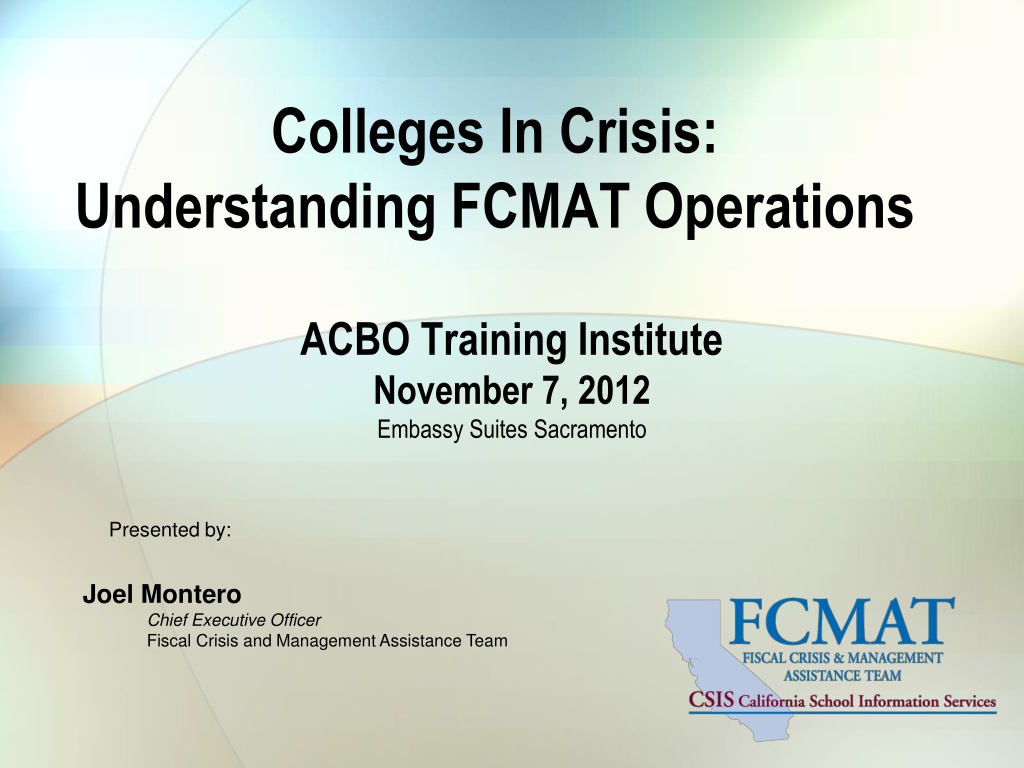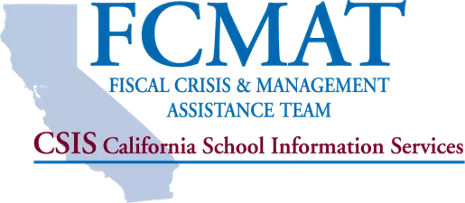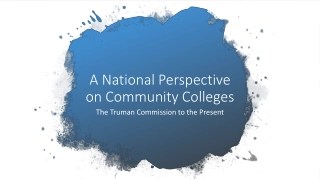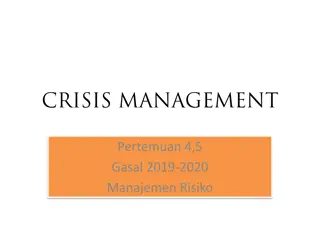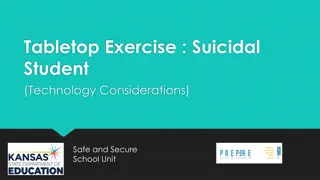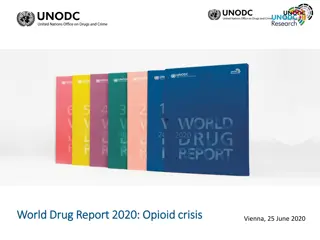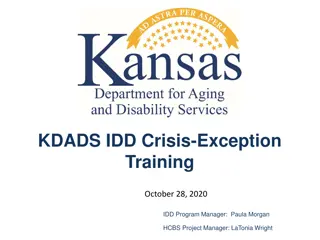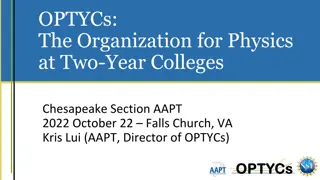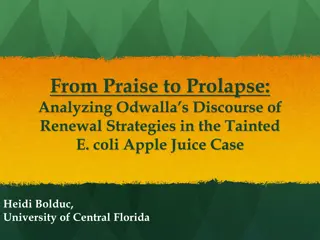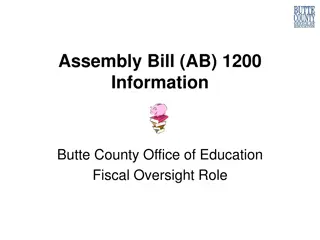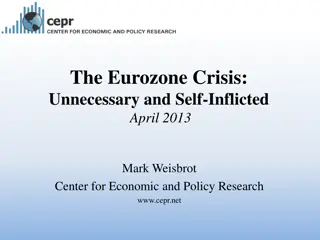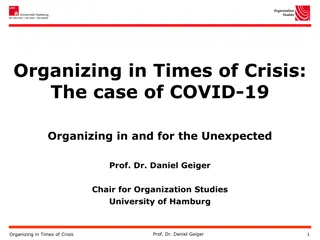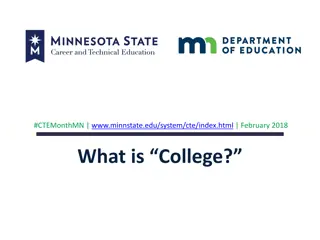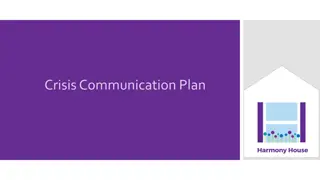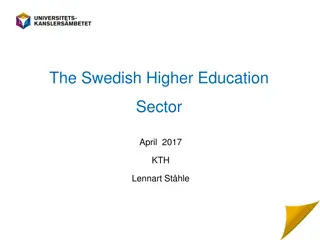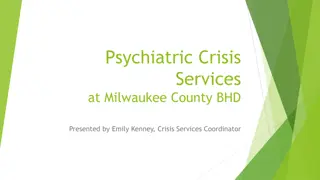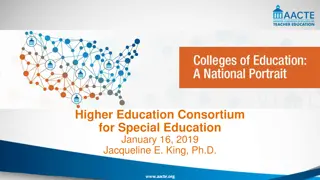Colleges in Crisis: FCMAT Operations Overview
The presentation delves into the roles and impact of the Fiscal Crisis and Management Assistance Team (FCMAT) in assisting education agencies facing financial challenges. Topics cover the changing CFO role, identifying financially troubled institutions, and strategies for survival in difficult budget environments.
Download Presentation

Please find below an Image/Link to download the presentation.
The content on the website is provided AS IS for your information and personal use only. It may not be sold, licensed, or shared on other websites without obtaining consent from the author.If you encounter any issues during the download, it is possible that the publisher has removed the file from their server.
You are allowed to download the files provided on this website for personal or commercial use, subject to the condition that they are used lawfully. All files are the property of their respective owners.
The content on the website is provided AS IS for your information and personal use only. It may not be sold, licensed, or shared on other websites without obtaining consent from the author.
E N D
Presentation Transcript
Colleges In Crisis: Understanding FCMAT Operations ACBO Training Institute November 7, 2012 Embassy Suites Sacramento Presented by: Joel Montero Chief Executive Officer Fiscal Crisis and Management Assistance Team
Overview Fiscal Crisis and Management Assistance Team The Budget Environment How it s changing the CFO role The Current Status Life after November 6th Definition of Financially Troubled Lessons of City College of San Francisco Monitoring and Assessment How To Survive the Short Term
The Role of FCMAT Field professionals just like you External and independent agency of the state Primary mission: assisting PK-14 education agencies in identification, prevention, and resolution of financial problems FCMAT staff and consultants perform studies and analyses at the request of education agencies, not just when there is trouble, but to promote effective and efficient operations May be called in by the district, the CC Board of Governors, Legislature, or the Governor
The Role of FCMAT FCMAT can help in: Determining the extent of the problem Providing facts that help resolve disputes Developing recovery plans Fraud investigation FCMAT also advises legislators on the need for state loans/takeovers FCMAT can be a valuable resource before you get into trouble, so ask for help If you get into trouble, FCMAT will almost certainly play a role in your recovery
Challenging Budget?Be Strategic Closing a $16 billion budget gap and assuming new revenue Cash crisis January to May 2013 in addition to ongoing deferrals Mid-year trigger for community colleges Unfunds COLAs Puts limits on Cal Grants for some New mandate block grant Hold harmless RDA revenues Flat funded??
What is Financially Troubled? A financially troubled district: May have a history of deficit spending May have CCFS 311/311Q reports that reveal fiscal issues May have GF unrestricted fund balance that is trending negative regarding the percentage related to expenditures and other outgo Cannot maintain a prudent, GF unrestricted fund balance of 5% May not conform to multiyear projection standards May not have enough cash to meet its obligations May have audit issues Has poor communication with the Systems Office
Common Causes of Financial Problems Overly optimistic estimates of state economics Declining enrollment or unstable enrollment/FTES Failure to document or change budget assumptions Loss of control of staffing levels and costs Underestimating automatic cost growth Use of one-time money for ongoing expenses Poor decisions at the negotiating table Failure to consider the multiyear impact of budget decisions Poor budget monitoring by the Administration and Board Chronic deficit spending Inadequate reserves Debt issues * See appendix for detail
Enrollment, FTES and Statistics K-12 Enrollment is on the Decline (Prop 98 Impact) Community Colleges serve 2.2 million Students (70% of post secondary) Had been predicting 1.5% annual growth through 2011-12 California recognizes the need for CC enrollment growth--44% over last 15 years Still CA population anticipated to be 44 million in 2050 Should have grown 5.5% in 09-10 but actually decreased by 4.8% In 09-10 CCCs sustained $520 million in reductions and turned away approximately 140,000 students Cost to the state to support one CC student is approximately $5000 as opposed to greater amounts for K-12, UC and CSU
CCC Revenues (disclaimer) 50% Property Taxes 33% State General Apportionment 8% Enrollment Fees* 3% Lottery Revenue 3% Non-Resident Fees* 4% Other and Miscellaneous Sources It s a zero sum game * Does not account for recent fee increases imposed by the Legislature ** Percentages are estimates and can vary depending upon a variety of factors *** Basic aid
What Happens if your District Gets into Financial Trouble?
Monitoring and Assessment of your Fiscal Condition Information used to perform the assessment include at least: Quarterly Financial Status Reports-CCFS-311Q Annual Financial Status Report-CCFS-311 Annual District Audit Apportionment Attendance Reports-CCFS-320 District response to inquiries from the Systems Office Remember, the System s Office s goal is to assist a district in resolving its financial problem at the lowest level of outside intervention The System Office can be more helpful when they get involved early.
Monitoring and Assessment of your Fiscal Condition Primary Assessment Criteria General Fund analysis Unrestricted fund balance analysis Review of object codes 1000 through 7000 Minimum Prudent Unrestricted Fund Balance = 5% (min) Secondary Criteria Spending patterns FTES review Salaries and benefits review Other audit findings, legal issues, timely filing of reports, etc.
Follow Up Actions if Necessary No Action All Systems Go! Periodic Monitoring Necessary Complete Checklist Update 311Q Create Action Plan to address concerns Communicate regularly with the Systems Office Management Assistance Required Complete Checklist Submit a Comprehensive 311Q Submit an Assistance Plan with the aid of FCMAT or other entity Participate in Quarterly Review by CEO and CBO/CFO May require the development and submission of a Recovery Plan
Follow Up Actions District Requires Fiscal Intervention Conduct a Comprehensive Management Review of the district and its educational programs and Audit the fiscal condition Direct district to amend and readopt Fiscal and Educational Plans based on the findings and recommendations of the Comprehensive Review Direct outside fiscal crisis intervention from FCMAT or other specialized entity Assign a Special Trustee to assume Management and Fiscal control of the district
What We Know Today The state s economic crisis will continue The state still has a structural deficit All things considered your challenge to manage cash is greater today than in prior years The Mid-Year Trigger Emergency Session The 2013-14 Budget?
City College of San Francisco A Case Study Solvency and Accreditation (show cause) Not an audit but a review of systems, fiscal realities and assumptions Findings: (highlights) Well above peers in terms of FTE staffing Well above it s faculty obligation number Not funded costs for workers comp, capital outlay, and retiree health benefit costs Relies on one-time actions to respond to fiscal condition Will deficit spend between $2.5m and 27.5m by 14-15 if no action taken Lacks enrollment management plan Data/information systems either non-existent or under utilized Unique management structure not accountable
What Can Districts Do Now in Anticipation of an Uncertain Fiscal Environment Plan Current plus Two Years + Review your Assumptions regarding Interest Income Spend Restricted Dollars First and Conserve Cash Stay Current With Enrollment and Staffing Build Reserves/Fund Balance If Possible Be Careful About Debt including OPEB Bonds Manage Cash Forego Big/Expensive Budget Decision Where Possible Don t Put All of Your Hopes In the Flexibility Basket Remember, This Is a Multi-Year Issue!
What Can Districts Do Now in Anticipation of an Uncertain Cash Environment Have a system in place to analyze and monitor cash flow all funds Report cash flow status and projection to the board on a regular basis Conserve cash when possible all funds Build Reserves/Fund Balance all funds Consider creating spending plans to manage available cash Consider options for dry period financing (borrowing) Don t run out!
Responsibilities of the District Characteristics of districts that avoid Pitfalls: Recognize when they have a problem Don t mask the problem (bad news does not improve with age) Take advantage of financial expertise available Work collaboratively with oversight agencies Are constantly Reassessing their Fiscal Position and Health Characteristics of districts that require severe measures: Deny they have a problem Resist scrutiny from outsiders Don t seek external assistance Combative with oversight agencies Panic
Summary A CEO and CBO/CFO have legal fiduciary responsibilities The vast majority discharge this duty well FS 05-05 requires fiscal transparency and cooperation A District and its Board must simultaneously: Review and report past budget performance Monitor and revise the current year budget Plan and prepare future budgets FCMAT is an agency designed to assist education agencies If a board gets into financial trouble, the System Office must step in The state does not bail out Districts from financial troubles A state loan comes with a state trustee
Twelve Ways Districts Get in Trouble #1 Estimates of State Economics Exposure Significant Professional Standard Maintain knowledge of state economics forecast Anticipate effect on your district Consider state economics in budget projections and revisions Definition State economics determine the allocations to Proposition 98 college funding based upon state revenues
Twelve Ways Districts Get in Trouble #2 Full Time Equivalent Students (FTES) Exposure Critical Professional Standard The district must have policies and procedures in place to appropriately forecast and track enrollment and FTES Definition Enrollment drives costs FTES partially drives revenues The calculation process by which information is translated into dollars is the Program Based Funding Model
Twelve Ways Districts Get in Trouble #3 Budget Assumptions Exposure Critical Professional Standard The district budget must be based upon a foundation of verifiable facts, and assumptions must be clearly stated Definition Budget assumptions are planning factors that stand in place of facts until those facts are known
Twelve Ways Districts Get in Trouble #4 Control of Staff Costs Exposure Critical Professional Standard Maintain staffing discipline within parameters adopted by the Board and State Definition Staffing control means that numbers of full time, part time, pay rates, assignments, overtime, and are kept within plans and budgets adopted by the Board and State. The 50% rule
Twelve Ways Districts Get in Trouble #5 Estimating Step, Column and Compensation Exposure Critical Professional Standard Districts must have tools and procedures to estimate the annual increase of salary and statutory benefit costs incurred each year as the result of step and column Definition Step: Dollar change between salary steps based on years of service Column: Dollar change between columns based on educational units or accomplishments
Twelve Ways Districts Get in Trouble #6 Use of One-Time Dollars Exposure Significant Professional Standard Ongoing expenses must be covered by ongoing revenues One-time dollars should not be used for ongoing expenses Definition One-time dollars include ending balances, audit adjustments, retroactive revenues, and other nonrecurring revenues
Twelve Ways Districts Get in Trouble #7 Negotiations Exposure To be determined by district Critical Significant Minor Professional Standard Maintain comparable compensation and working conditions within the district s ability to pay Balance compensation needs with student needs Definition Collective bargaining is required by the Rodda Act Must negotiate in good faith
Twelve Ways Districts Get in Trouble #8 Multiyear Planning Exposure Critical Professional Standard Multiyear Planning current plus 2 years Long-term impact must be assessed Definition MYP considers the out-year impact of today s decisions
Twelve Ways Districts Get in Trouble #9 Execution of the Budget Exposure Significant Professional Standard The district must adhere to the approved spending Revisions should be approved before different decisions are implemented Definition Execution of the budget means sticking to the spending plan adopted by the Board
Twelve Ways Districts Get in Trouble #10 Budget Monitoring Exposure Critical Professional Standard The Systems Office requires districts to monitor and perform self- assessment The budget should be revised when necessary Definition Budget monitoring means actual results are compared with planned results and adjustments are made
Twelve Ways Districts Get in Trouble #11 Deficit Spending Exposure Critical Professional Standard The budget should be balanced Any deficit spending should be visible and explained Definition Deficit spending means the district is spending beyond its means
Twelve Ways Districts Get in Trouble #12 Estimating the Ending Fund Balance (EFB) Exposure Critical Professional Standard A district must have the ability to accurately reflect its net ending balance throughout the budget monitoring process. The CCFS 311Q reports should provide valid updates of the district s projected net ending balance. The district should have tools and procedures that ensure an early warning of any discrepancies between the budgeted and actual revenues and expenses Definition When all is said and done and the books have been closed, it is the amount of money remaining in the fund, net of any designations in the restricted and unrestricted accounts. Budget to actuals
Twelve Ways Districts Get in Trouble #13 Management of Cash Exposure Critical Professional Standard All districts must project cash balances on a weekly basis and prepare appropriate cash flow documents in order to assess the need for short term borrowing and the potential of cash insolvency. Definition Cash is not budget and understanding the difference between these two things is critical for boards, superintendents and staff. Cash position represents the actual available dollars at any given time held in the county treasury.
